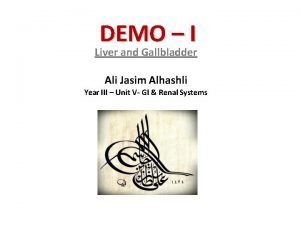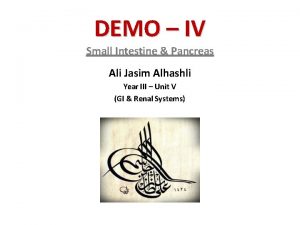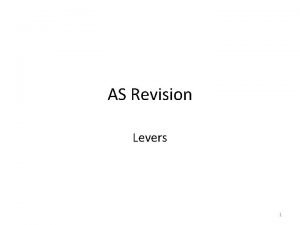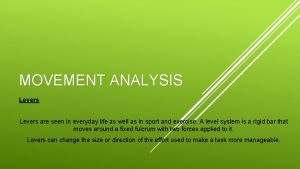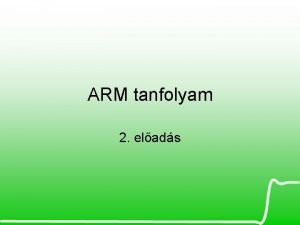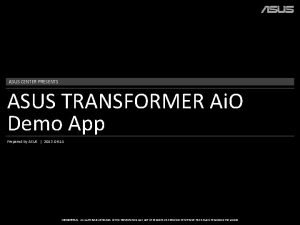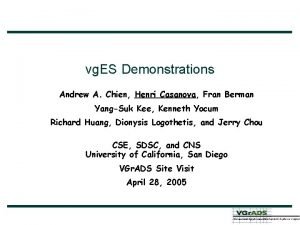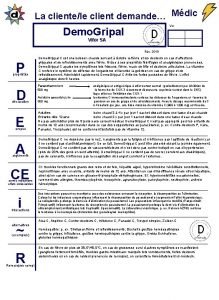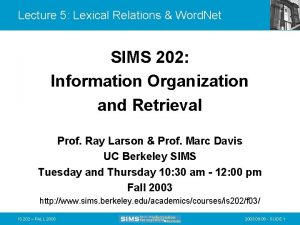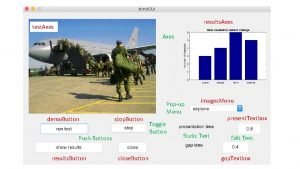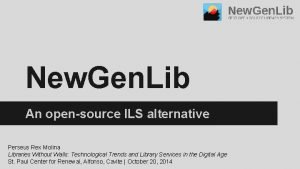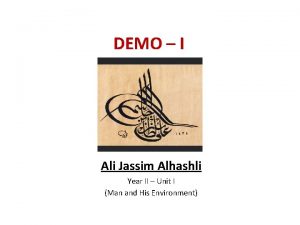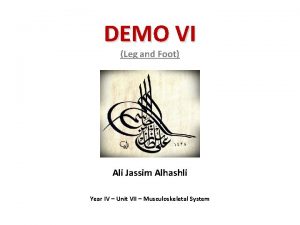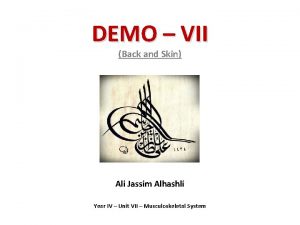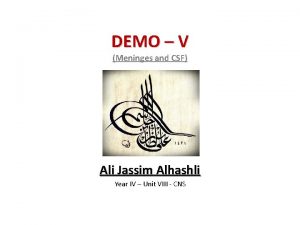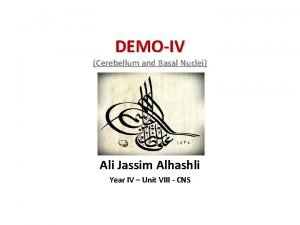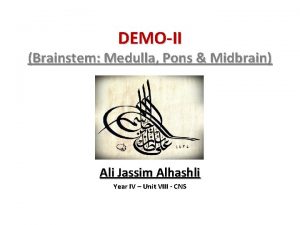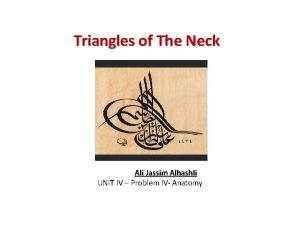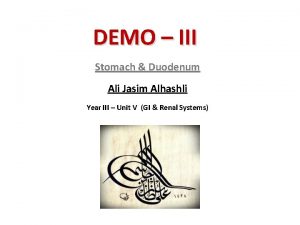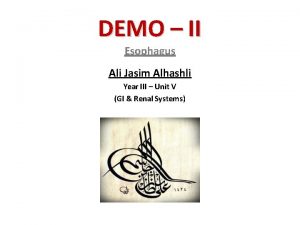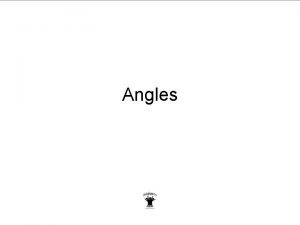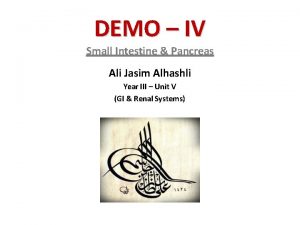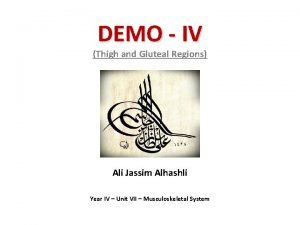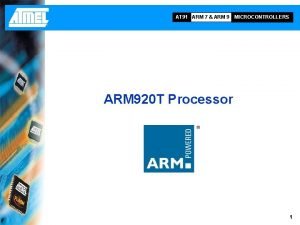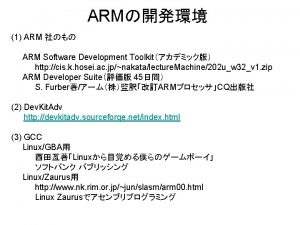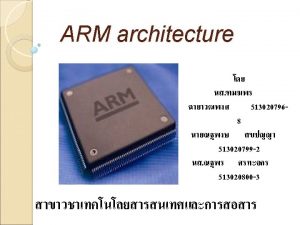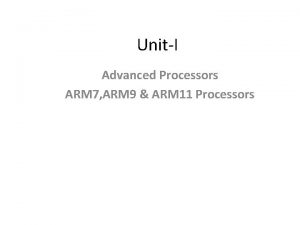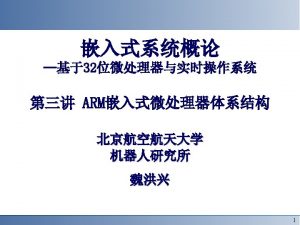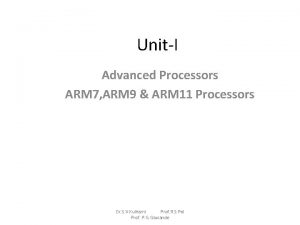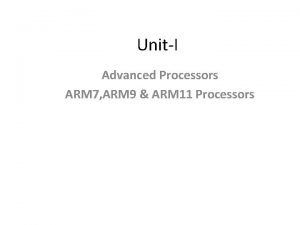DEMO II Arm Ali Jassim Alhashli Year IV



























- Slides: 27

DEMO – II (Arm) Ali Jassim Alhashli Year IV – Unit VII – Musculoskeletal System

STATION – 1 (Gross Anatomy) Muscles of The Arm, Cubital Fossa, Triangular & Quadrangular Spaces • The arm extends from the shoulder to the elbow. • 2 types of movement occur between the arm and the forearm at the elbow joint: – Flexion-extension – Pronation-supination • There are 4 arm muscles: – 3 flexors: biceps brachii, brachialis & coracobrachialis. • Note: these muscles are supplied by the musculocutaneous nerve. – 1 extensor: triceps brachii. • Note: this muscle is supplied by the radial nerve. • A small triangular muscles on the posterior aspect of the elbow, the anconeus, covers the posterior aspect of the ulna proximally. It helps the triceps extending the forearm and also abducts the ulna during pronation of the forearm.

STATION – 1 (Gross Anatomy) Muscles of The Arm, Cubital Fossa, Triangular & Quadrangular Spaces • Biceps brachii: – Has 2 heads: • Long head: originating from supraglenoid tubercle. • Short head: originating from tip of coracoid process. – The transverse humeral ligament: passes from the lesser to the greater tubercle of the humerus and converts the intertubercular groove into a canal for the tendon of the long head of the biceps. – Bicipital aponeurosis: runs from the biceps tendon across the cubital fossa and merges with the antebrachial (deep) fascia covering the flexor muscles in the medial side of the forearm.

STATION – 1 (Gross Anatomy) Muscles of The Arm, Cubital Fossa, Triangular & Quadrangular Spaces • • Brachialis: – Flattened, fusiform muscle which lies posterior (deep) to the biceps. – It is the only pure flexor, producing the greatest amount of flexion force. – When the forearm is extended slowly, the brachialis steadies the movement by slowly relaxing – It originates from the distal half of anterior surface of humerus and inserts in the coronoid process and tuberosity of ulna. Coracobrachialis: – Elongated muscle in the superomedial part of the arm. – The musculocutaneous nerve pierces it. – The distal part of its attachement indicates the location of the nutrient foramen of the humerus. – Coracobrachialis helps flex and adduct the arm and stabilize the glenohumeral (shoulder) joint. – It originates from the tip or coracoid process and inserts in the middle third of anterior surface of the humerus.

Muscles of The Arm, Cubital Fossa, Triangular & Quadrangular Spaces STATION – 1 (Gross Anatomy) • Triceps brachii: – Large, fusiform muscle in the posterior compartment of the arm. – It arises by: • Long head: which originates from infraglenoid tubercle. • Lateral head: which originates from posterior surface of the humerus, superior to radial groove. • Medial head: which originates from posterior surface of humerus, inferior to radial groove. – It is the main extensor of the elbow. – Because its long head crosses the glenohumeral joint, the triceps helps stabilize the adducted glenohumeral joint by serving as a shunt muscle, resisting inferior displacement of the head of the humerus.

STATION – 1 (Gross Anatomy) Muscles of The Arm, Cubital Fossa, Triangular & Quadrangular Spaces

STATION – 1 (Gross Anatomy) Muscles of The Arm, Cubital Fossa, Triangular & Quadrangular Spaces • • Cubital Fossa: shallow triangular depression on the anterior surface of the elbow. The boundaries of the cubital fossa are: – Superiorly: imaginary line connecting the medial and lateral epicondyles – Medially: pronator teres. – Laterally: brachoradialis. The contents of the cubital fossa are (from lateral to medial): – Radial nerve: dividing into superficial and deep branches. – Biceps brachii tendon. – Terminal branch of the brachial artery. – Median nerve. In the subcutaneous tissue overlying the cubital fossa is the median cubital vein, lying anterior to the brachial artery (used clinically for venipuncture).

STATION – 1 (Gross Anatomy) Muscles of The Arm, Cubital Fossa, Triangular & Quadrangular Spaces

STATION – 1 (Gross Anatomy) Muscles of The Arm, Cubital Fossa, Triangular & Quadrangular Spaces • • • Quadrangular space: – Borders: • Superior: teres minor. • Inferior: teres major. • Medial: long head of triceps. • Lateral: shaft of humerus. – Contents: • Axillary nerve : innervating the teres minor and deltoid and providing sensation to the lateral arm. • Posteior humeral circumflex artery. Triangular space: – Borders: • Superior: teres minor. • Inferior: teres major. • Lateral: long head of triceps. – Contents: • Scapular circumflex artery. Triangular interval: – Borders: • Superior: teres major. • Medial: long head of triceps. • Lateral: lateral head of triceps. – Contents: • Radial nerve. • Deep artery of the arm.

STATION – 2 (Surface anatomy) • • Dislocation of the head of the humerus mostly occurs anteriorly and inferiorly. When this happens, the shoulder prominence will disappear and instead of having a rounded contour it will become flat. Normally, it is difficult to feel the head of the humerus (especially in muscular people – thin people are an exception) but the greater tubercle of the humerus can be felt in majority of people. The tip of coracoid process of the scapula (a bony prominence) is felt by compressing the area below the junction of the middle 1/3 and lateral 1/3 of the clavicle (deep in the deltopectoral triangle). When there is dislocation of the head of humerus from the shoulder joint, it can be felt below the coracoid process (subcoracoid location). Shoulder prominence

STATION – 2 (Surface anatomy) • Supraepicondylar humerus fracture: – it is a fracture of the distal humerus just above the epicondyles. While relatively rare in adults, it is one of the most common fractures to occur in children and is often associated with the development of serious complications. – Direct damage or swelling can cause the interference to the blood supply of the forearm via the brachial artery. The resulting ischemia can cause Volkmann’s Ischemic Contracture – uncontrolled flexion of the hand, as flexors muscles become fibrotic and short. There also can be damage to the median, ulnar or radial nerves. Lateral epicondyle in the distal end of the humerus Olecranon process of the ulna occupying the olecranon fossa of the humerus during extension of the elbow Medial epicondyle in the distal end of the humerus

STATION – 2 (Surface anatomy) • • • Anterior axillary fold is formed by: pectoralis major muscle. Posterior axillary fold is formed by: latissimus dorsi + teres major. Axillary artery can be felt around the surgical neck of the humerus. A pulse can be measured from it (figure) The brachial artery is a continuation of the axillary artery. It runs in the medial side of the lower 1/3 of the arm and then branches in the cubital fossa to radial and ulnar arteries (figure). It is a used in anesthesia of the upper limb + controlling hemorrhage by compressing it. The elbow joint is a compound joint composed of: – Humero-ulnar: hinge type. – Humero-radial: ball and socket. – Proximal radio-ulnar joint: pivot type. If you want to feel you ulnar nerve, flex your elbow joint → place a finger behind the medial epicondyle → roll and pull up!

STATION – 3 (Bones + Radiology) • • The anatomical neck of the humerus is distal to its round head which is articulating with the glenoid cavity of the scapula at the glenohumeral joint (shoulder joint). The humerus has 2 tubercles: greater and lesser. Distal to these tubercles is the surgical neck of the humerus (one of the most common sites of fracture in the humerus). A fracture in this area might lead to axillary nerve damage which will result in paralysis of deltoid + teres minor muscles and loss of sensation in lateral arm. The shaft of the humerus is characterized by: – Deltoid tuberosity: point of distal attachment of deltoid muscle. – Radial groove: for the passage of the radial nerve and deep artery of the arm. Ulnar nerve (musician nerve) is passing in a groove behind the medial epicondyle of the distal end of humerus. Cubital tunnel syndrome: is a condition that involves pressure or stretching of the ulnar nerve which can cause numbness or tingling in the ring (medial half) and small fingers, pain in the forearm and/or weakness in the hand.

STATION – 3 (Bones + Radiology) • • Fractures of the humerus: – Fracture in the surgical neck: axillary nerve damage. – Mid-shaft fracture: damage to the radial nerve. – Medial epicondyle fracture: damage to the ulnar nerve. Attachments of muscles of the arm (see images below):

STATION – 3 (Bones + Radiology) • Ulna: – Stabilizing bone of the forearm. – Medial. – Longer. – The proximal end has 2 projection: • Olecranon posteriorly. • Coronoid process anteriorly: – Inferior to the coronoid process is the tuberosity of the ulna. – On the lateral side of coronoid process is the radial notch. Both of these projections form the wall of trochlear notch. – Proximally, the shaft of the ulna is thick, but it tapers, diminishing in diameter distally. – Head of the ulna has a small conical ulnar styloid process. – Note: the ulna does not articulate directly with the carpal bones. It is separated from the carpals by a fibrocartilaginous articular disc.

STATION – 3 (Bones + Radiology) • Radius: – Lateral – Shorter – The proximal end consists of: • Cylindrical head: superior aspect of the head of the radius is concave for articulation with the capitulum of humerus. The head also articulates medially with the radial notch of ulna. • Short neck: it is the narrow part between the head and the radial tuberosity. • Radial tuberosity: demarcates the proximal end (head & neck) from the shaft. – The medial aspect of the distal end of the radius forms a concavity, the ulnar notch, which accommodates the head of the ulna. – Radial styloid process is larger than the ulnar styloid process. – Dorsal tubercle of the radius lies between 2 of the shallow grooves for passage of the tendons of forearm muscles.

STATION – 3 (Bones + Radiology)

STATION – 3 (Bones + Radiology) • Subluxation (partial dislocation) of the radial head: – It occurs in pre-school children. – Incomplete (temporary dislocation) of the head of the radius (pulled elbow). – Occurs when the child is suddenly lifted (jerked) by the upper limb when the forearm is pronated. – The radial head moves distally and partially out of the anular ligament. – The treatment of subluxation consists of supination of the child’s forearm while the elbow is flexed.

STATION – 3 (Bones + Radiology) • Bursae around elbow joint: – Intratendinous olecranon bursa: present in the tendon of triceps brachii. – Subtendionous olecranon bursa: between the olecranon and the triceps tendon. – Subcutaneous olecranon bursa: in the subcutaneous connective tissue over the olecranon. When this bursa is inflamed, it is known as student’s bursa.

STATION – 3 (Bones + Radiology)

STATION – 4 (Histology of Bone) • • There are 4 types of tissue in the body: – Epithelium. – Connective tissue. – Muscle tissue. – Nerve tissue. Cartilage, bone and blood represent connective tissue. As a connective tissue, the bone has 3 characteristics: – Fibers: collagen type-I – Matrix or ground substance: composed mainly of calcium. – Cells: osteoblasts, osteocytes and osteoclasts. The bone itself is divided into compact bone and spongy bone (in which the marrow is present).

STATION – 4 (Histology of Bone) • Compact bone: – It has a connective tissue capsule from outside (external) known as the periosteum. – The internal connective tissue lining (near the bone marrow) is known as the endosteum. – Collagen fibers will form the layout for bone structures. There are four main collagen arrangements: • Internal circumferential lamellae. • External circumferential lamellae. • Concentric lamellae: around Haversian Canals. • Interstitial lamellae. – Canaliculi is the connection between different osteocytes present in an osteon. – Osteoblasts are bigger and more active than osteocytes (both of these cells are derived from the mesenchyme). – Osteoclasts are derived from blood monocytes. These cells are seen with multiple nuclei.

STATION – 4 (Histology of Bone)

STATION – 4 (Histology of Bone)

STATION – 5 (Additional: Brachial Plexus) • • Brachial plexus: is a major network of nerves supplying the upper limb. Begins in the lateral cervical region and extends into the axilla. It is originating from the anterior rami of the C 5 -T 1 nerves which constitute the roots of brachial plexus. The roots usually pass through the gap between the anterior and middle scalene muscles with the subclavian artery. The roots of the brachial plexus unite to form 3 trunks: – Superior trunk: C 5 and C 6 – Middle trunk: C 7 – Inferior trunk: C 8 and T 1 Each trunk of the brachial plexus divides into anterior and posterior divisions: – Anterior division: supply the anterior (flexor) compartments of the upper trunk. – Posterior divisions: supply the posterior (extensor) compartments of the upper trunk. The divisions of the trunks form three cords of the brachial plexus within the axilla: – Lateral cord. – Medial cord. – Posterior cord. Note: the cords of the brachial plexus are named for their position in relation to the second part of the axillary artery.

STATION – 5 (Additional: Brachial Plexus)

Good Luck! Wish you all the best
 Alhashli
Alhashli Jejunum arcades
Jejunum arcades Intracoronal clasp
Intracoronal clasp Effort arm and resistance arm
Effort arm and resistance arm Disadvantages of third class levers
Disadvantages of third class levers Levers used in everyday life
Levers used in everyday life Linker arm left arm
Linker arm left arm Infrabulge clasps originate
Infrabulge clasps originate Poem for leaving primary school
Poem for leaving primary school Demo
Demo Oceannodes
Oceannodes Xero tips and tricks
Xero tips and tricks Hulk
Hulk Camtasia demo
Camtasia demo Taskray demo
Taskray demo Seafile vs
Seafile vs Henri casanova
Henri casanova Hyperion planning demo
Hyperion planning demo Paspertine
Paspertine Sims.net demo
Sims.net demo Aka.ms/hci-demo
Aka.ms/hci-demo Wikifin demo bank
Wikifin demo bank Nagios log server demo
Nagios log server demo Microsoft dynamics onboarding
Microsoft dynamics onboarding Combining logic gates
Combining logic gates Setinitialproperties
Setinitialproperties Diana collington
Diana collington Nicelabel alternative
Nicelabel alternative
